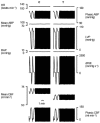The effect of dehydroepiandrosterone on coronary blood flow in prepubertal anaesthetized pigs
- PMID: 12702737
- PMCID: PMC2342994
- DOI: 10.1113/jphysiol.2003.040170
The effect of dehydroepiandrosterone on coronary blood flow in prepubertal anaesthetized pigs
Abstract
Extensive research suspecting an association between plasma levels of dehydroepiandrosterone and the risk of coronary heart disease has not been conclusive. The present study was designed to investigate the effect of dehydroepiandrosterone on the coronary circulation and to determine the mechanisms involved. In prepubertal pigs of both sexes anaesthetized with sodium pentobarbitone, changes in left circumflex or anterior descending coronary flow caused by intravenous infusion of dehydroepiandrosterone were assessed using an electromagnetic flowmeter. Changes in heart rate and arterial pressure were prevented by atrial pacing and by connecting the arterial system to a pressurized reservoir containing Ringer solution. In 20 pigs, infusion of 1 mg h-1 of dehydroepiandrosterone caused a decrease in coronary flow without affecting left ventricular dP/dtmax (rate of change of left ventricular systolic pressure) and filling pressures of the heart. In a further eight pigs, a dose-response curve was obtained by graded increases in the infused dose of hormone between 0.03 and 4 mg h-1. The mechanisms of the above response were studied in the 20 pigs by repeating the experiment after haemodynamic variables had returned to the control values observed before infusion. Blockade of muscarinic cholinoceptors with intravenous atropine (five pigs) and of alpha-adrenoceptors with intravenous phentolamine (five pigs) did not affect the dehydroepiandrosterone-induced coronary vasoconstriction. This response was abolished by blockade of beta-adrenoceptors with intravenous propranolol (five pigs) and of coronary nitric oxide synthase with intracoronary injection of Nomega-nitro-L-arginine methyl ester (five pigs) even after reversing the increase in arterial pressure and coronary vascular resistance caused by the two blocking agents with intravenous infusion of papaverine. The present study showed that intravenous infusion of dehydroepiandrosterone primarily caused coronary vasoconstriction. The mechanisms of this response were shown to involve the inhibition of a vasodilatory beta-adrenergic receptor-mediated effect related to the release of nitric oxide.
Figures




References
-
- Alexandersen P, Haarbo J, Christiansen C. The relationship of natural androgens to coronary heart disease in males: a review. Atherosclerosis. 1996;125:1–13. - PubMed
-
- Barbagallo M, Shan J, Pang PK, Resnick LM. Effects of DHEA sulfate on cellular calcium responsiveness and vascular contractility. Hypertension. 1995;26:1065–1069. - PubMed
-
- Barrett-Connor E, Goodman-Gruen D. The epidemiology of DHEAS and cardiovascular disease. Ann N Y Acad Sci. 1995a;774:259–270. - PubMed
-
- Barrett-Connor E, Goodman-Gruen D. DHEA sulfate does not predict cardiovascular death in postmenopausal women. Circulation. 1995b;91:1757–1760. - PubMed
-
- Barrett-Connor E, Khaw KT, Yen SS. A prospective study of DHEA sulfate, mortality, and cardiovascular disease. N Engl J Med. 1986;315:1519–1524. - PubMed
Publication types
MeSH terms
Substances
LinkOut - more resources
Full Text Sources

